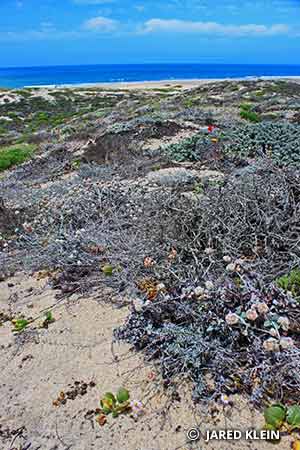Dunes Alive - The Endangered Smith's Blue and Marina Blue Butterflies
A closer look at Coastal Dune Wildlife of South Monterey Bay
by Dave Dixon

The surprisingly small and subtly beautiful Smith's blue butterfly, (Euphilotes enoptes smithi), was officially recognized in 1976 as an Endangered Species. It was one of the first insects to receive protection through Federal Endangered status. Instead of just quietly disappearing from life on earth the Federal Endangered Species Act formally recognized that the butterfly was in trouble. This began a story that weaves through the fabric of life in the dunes of south Monterey Bay.
Smith's blue butterfly has only been known in the scientific literature for a little more than 50 years. Rudi Mattoni and his friend Claude I. Smith, while undergraduates at U.C. Berkeley discovered it in 1948. They ventured south to Big Sur in early summer. At Dolan's Creek, Mattoni collected the blue butterfly that they had never seen, which he kept for further study. Smith died an untimely death a few years later, swept to sea while fishing from a rock at Half Moon Bay. He had not yet published the work that was to have been his dissertation, a revision a genus of a dayflying moth. In tribute to his friend, Mattoni gave Smith's name to the butterfly they had discovered exploring Big Sur.
To understand the endangered Smith's blue butterfly problem one must understand its habitat. Dune experts agree that it is the coastal dune habitat that is endangered. They say that freeway building and urbanization have destroyed roughly 50 percent of the original dunes. Coastal dunes also have an extremely high concentration of Federal and State listed Threatened and Endangered Species. In 1980, coastal dune habitat near the mouth of the Salinas River was designated as a National Wildlife Refuge, and became part of the San Francisco Bay National Wildlife Refuge Complex. It was created to protect threatened and endangered species that were dependent on the fragile dune environment, including the Smith's blue butterfly. According to the Federal Endangered Species Act, Endangered means 'likely to become extinct in the foreseeable future'. Plants and animals that live in coastal dunes are adapted to the scouring effects of wind-blown sand (being sandblasted), as well as foggy weather and extremely drying conditions made worse by salt-spray from the ocean. Most dune dwelling organisms specialize in the sandy life. The evolutionary cost of their specialized adaptations often results in a limited capacity to compete and survive in adjacent habitats. When 50 percent of the habitat is gone and specialized adaptations have excluded the ability to survive in other habitats, this becomes the mechanism of their endangerment.
The Smith's blue butterfly is a member of a family of very small North American butterflies known as the Lycaenids. In fact, the smallest butterfly in the in North America, the pygmy blue is a Lycaenid. It's wing span is scarcely more than a half of an inch. Comparatively, Smith's blue butterflies have a wingspan of just under an inch.
In addition to their small size, Smith's blue butterflies live for a very short time, for only about one week. Their single week of daytime-only flight is further limited to temperatures above 60 degrees and when there are no strong winds or in areas where they are sheltered from the wind. To survive they have a lot to do in their short week as adults. In addition to taking care of their own individual health like feeding, avoiding sickness and predation, they must also find and court a mate, and copulate. Then the female must lay the eggs of next year's generation. Early season males may have a harder time finding females since the first-of-the-season females start emerging about a week after the first males. Butterfly observers occasionally find several males congregating around a newly emerging female. Stimulated by pheromones emitted from the female, they become eager to mate before the end of their short lives. The overall population of adults is active for about 8 to 12 weeks between early June to September. It is no wonder that they are having trouble surviving.
Another limiting factor is that most butterflies fly less than 200 feet from where their lives began as eggs. Roadways are considered barriers that may isolate Smith's blue butterfly colonies from each other. Highway 1 in Sand City, built right through the middle of its critical habitat creates one such barrier. If the width of a six-lane freeway were not enough, cars cutting through the air space at 65 miles per hour also pose a lethal threat of becoming a hood ornament or getting run over.
For thousands of years these tiny butterflies have developed a reliable codependency on just two species of buckwheat that inhabit the coast. They feed, mate, and lay their eggs exclusively on the flower heads of Coast buckwheat (Eriogonum latifolium) and Seacliff buckwheat (Eriogonum parvifolium). Smith's blue butterfly has resided in the dunes for eons. It is only for the last 50 years that human impacts have caused their endangerment as their buckwheat host plants have begun to get wiped out by human activities.
It is interesting how butterflies and buckwheat flowers have coevolved. Adult butterflies have fascinating mouthparts that closely match the flowers upon which they feed. Their mouth is a long hollow tube proboscis that is kept coiled up until they are ready to feed. This straw-like structure is used to reach deep into flowers to suck out the nectar. The length of the uncoiled tube closely matches the depth of the floral tube from the corolla and the nectary. The butterfly has coevolved with the buckwheat plant to be a good fit. The flower is adapted to feed nectar to the butterfly. In return the butterfly flies from flower to flower carrying pollen from one flower to the next. This assists the buckwheat with the vital service of cross-pollination.
The buckwheat flower also serves as the Smith's blue butterfly nursery. The female butterfly lays single eggs into buckwheat flower heads. In about a week the egg hatches and becomes a larva or caterpillar. The larvae have chewing mouthparts they use to feed on petals, and seeds in the flower head. Larvae are cryptically colored, closely matching the pinkish to creamy white color of the blossoms where they hide. The caterpillar matures through four larval stages called instars in three to four weeks before becoming a chrysalis. Chrysalis formation or pupation then takes place in the flower head or in the leaf litter. The pupa eventually falls into leaf litter and topsoil beneath the buckwheat plant. Finally the chrysalis lies hidden at the base of the buckwheat plant the remaining 47 weeks of the 52-week year at which time, if all goes well the cycle of life produces the next generation of butterfly.
Recently it has been suggested that the population of Smith's blue butterfly that specializes on coast buckwheat should be reclassified into a new subspecies, called the Marina blue butterfly (Euphilotes enoptes arenacola). The subspecies name "arenacola" means "sand dweller", in reference to the sand dune habitat found exclusively in the Marina dunes, ranging from the northern portion of former Fort Ord to just north of the Salinas Rivermouth. In contrast the Smith's blue butterfly (Euphilotes enoptes smithi) is found on seacliff buckwheat on bluffs and cliffs from southern former Fort Ord south to southern coastal Monterey County, the coastal portion of the Santa Lucia Mountains and inland to Carmel Valley. The distinction given to the Marina blue butterfly by its reclassification further emphasizes its endangerment in the dunes.
The difference in blooming times between seacliff and coast buckwheat may instigate a temporal breeding barrier between the Smith's blue and the proposed Marina blue butterflies using each species of buckwheat, resulting in the two potentially distinct subspecies of butterflies. Coast buckwheat blooms up to 1 month before seacliff buckwheat. Adult butterflies emerge to breed precisely as the respective host plants bloom. As we cultivate the two buckwheat species, maintaining geographical separation of seacliff and coast buckwheat will help maintain each butterfly's genetic integrity.
Restoration efforts are also very much focused on controlling the aggressive and invasive non-native European beach grass (Ammophila arenaria) and South African iceplant (Carpobrotus edulis). These two plants have reduced the abundance and range of the host buckwheat plants. To address this problem the California Park Service along with the U.S. Fish and Wildlife Service and other organizations and individuals are removing non-native species of plants and replacing them with local dune natives. The strategy involves creation of buckwheat corridors to connect smaller patches into a buckwheat network. In this way the health of the buckwheat population and its dependant butterflies is improved.
Successful restoration management should also account for ecological relationships with other dune insects. Smith's blue butterflies have a mutualistic relationship with ants where each party receives a benefit. Ants help the larvae survive by protecting them from predatory spiders and parasitic wasps. In return the tending ants profit by feeding on a sugary substance the caterpillar excretes from the surface of its abdomen. Efforts to improve the health of Smith's blue butterfly populations may be assisted by focusing on the health of the tending ants.
An ecosystem approach to understanding butterfly habitat is first needed to enable an effective response. The Smith's blue butterfly lives in an ecosystem that has been significantly degraded. Environmental stressors (i.e., development, human recreation, freeways, sand mining, etc.) have adversely affected the biological diversity of the coastal dune ecosystem. Many of the characteristics that attract people to coastal areas make these areas prime habitat for wildlife resources. Although they comprise less than 10 percent of the Nation, coastal ecosystems are home to over one-third of the U.S. human population (expected to grow to 75 percent by 2010). The coasts also provide habitat for 45 percent of all threatened and endangered species including three-fourths of the federally listed birds and mammals. Proper stewardship of this unique ecosystem is needed to maintain its ecological integrity while meeting its human demands.
The quality of life in our south Monterey Bay coastal dunes is reflected by its population of Marina blue butterfly. Do we want to preserve the quality of life that we have enjoyed? It took us 50 years to create the problem. To save it our vision must extend even further into the future. Community involvement is essential to sustain the conservation effort over the long run. I believe that it is through these efforts that one day we may bring back the Marina blue butterfly from the brink of extinction. State Park staff welcomes volunteer participation in weekly monitoring outings into butterfly habitat. Please join us in helping save the Smith's blue butterfly.
Suggested Reading:
Arnold, R.A. 1983. Conservation and management of the endangered Smith's blue butterfly, Euphilotes enoptes smithi. Jour. Res. Lepid. 22: 135-153.
Mattoni, R.H.T. 1954. Notes on the genus Philotes: I. Descriptions of three new subspecies and a synoptic list. Bull. So. CA. Acad. Sci. 53:157-165.
Powell, J.A. 1981. Endangered habitats for insects: California coastal sand dunes. Atala 6:41-55.
Pratt, Gordon F. and John F. Emmel. 1998. Revision of the Euphilotes enoptes and E. Battoides complexes (Lepidoptera: Lycaenidae) in Systematics of Western North American Butterflies, Thomas C. Emmel, editor. Pages 207-270. Mariposa Press, Gainsville, Florida.
U.S. Fish and Wildlife Service. 1984. Smith's Blue Butterfly Recovery Plan. U.S. Fish and Wildlife Service, Portland, OR. 87 pp.
About the Author
Dave Dixon has been leading recovery efforts in the south Monterey Bay dunes since 1985. He is a member of the Western Snowy Plover Recovery Team. He has been a State Park Ranger since 1976. He has a bachelors degree in biology from San Jose State University.





